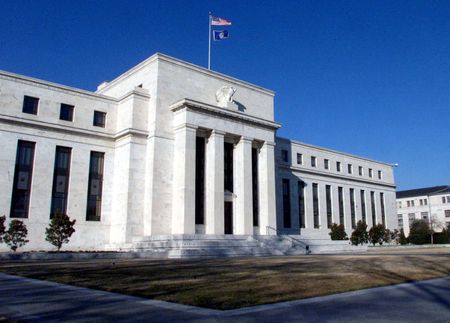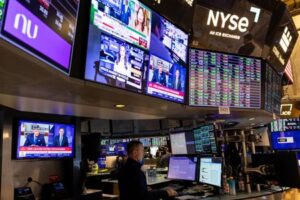By Howard Schneider
WASHINGTON (Reuters) – Ford Motor’s announced price cut this week for the electric version of its F-150 truck was attributed to a number of factors, including competition among manufacturers, an oversupply of vehicles, and confusion about federal tax credits.
But it also showed how a gradual return to pre-pandemic norms offers the Federal Reserve a fighting chance at lowering inflation without ruining the job market or causing a recession, a scenario dubbed the “soft landing.”
The healing of supply chains has allowed output to grow, even as still-healthy consumer balance sheets buoy demand. The result: Both output and sales have remained strong even as the pace of price increases has declined, a realignment of the inflation-inducing situation seen during the coronavirus pandemic when consumers were even more flush with cash and companies couldn’t keep up.
The U.S. central bank’s battle with inflation isn’t over, and developments like Russia’s recent disavowal of a grain export agreement with Ukraine could still make things worse.
An important measure of inflation, the personal consumption expenditures price index excluding food and energy, has been stuck at around 4.6% for six months, more than double the Fed’s 2% target.
But across the economy there are signs of pandemic-era imbalances being righted – not in a pure return to what existed before or in a fully unfamiliar “new normal,” but in a hybrid that for now is allowing inflation to cool while the economy keeps growing.
The Atlanta Fed’s GDPNow outlook for U.S. growth from April through June is currently 2.4% on an annualized basis, well above estimated trend growth of around 1.8%.
Even so, Pantheon Macroeconomics economists Ian Shepherdson and Kieran Clancy said consumer price inflation by the fall may have plunged to near 1% on a three-month basis.
After supply problems, “revenge spending” and outsized corporate profit margins helped drive inflation above 9% in June 2022, they now argue “excess global capacity in goods, softening demand for domestic discretionary services, and margin re-compression will work its way through.”
“The signal for the foreseeable future is one of downward pressure everywhere.”
DIFFERENT THIS TIME?
The Fed next week is expected to raise interest rates by a quarter of a percentage point to the 5.25%-5.50% range, a move that would mark its 11th increase in 12 meetings since March 2022. Recent data, including lower-than-expected inflation and moderating job growth, have convinced many investors and analysts the hike will be the last of the current tightening cycle, with only 19 of 106 economists in a Reuters poll forecasting a hike after July.
Fed policymakers have penciled in at least one more increase beyond that but are wrestling with how much weight to put on risks that inflation could reignite and require even higher rates versus concerns the economy has not adjusted to the increases already approved and may weaken fast.
Arguments for both are well grounded.
The track record for controlling high inflation without significant job losses is poor. To some policymakers, the current 3.6% unemployment rate, with annual wage growth exceeding 4%, means the job market remains too hot. That said, whenever interest rates have risen as fast as they have or inflation has fallen as much as it has, the unemployment rate eventually rises, a reason some policymakers believe the Fed has done enough and needs to give the economy time to adjust.
The issue both sides are confronting is whether an economic moment that began with an unprecedented shock can evolve in unprecedented ways.
Indeed, the list of things that may make this time different is lengthy.
Developments typically running alongside steep Fed rate increases, for example, such as construction job losses, haven’t occurred. While higher borrowing costs hurt home construction, builders were deployed instead on factories, warehouses and infrastructure projects fueled by pandemic-era spending.
Bankruptcies have started rising, reversing low pandemic-era failure rates when firms and families were sustained with various programs. But business formations remain elevated, which may support small business growth and hiring.
Growth in bank lending has slowed, as it typically does when the Fed raises rates. But much of that is tied to declines in bank holdings of securities, while small businesses in a recent survey indicated they were borrowing at about pre-pandemic levels.
If the trillions of dollars that households accumulated through pandemic-relief payments fueled the initial outbreak of inflation, they currently may be the buffer leading retail sales to slow, but not crater, under the weight of high interest rates.
Average household war chests are now just about 15% above pre-pandemic levels, JP Morgan Chase Institute analysts estimated recently. The fact they have fallen that low may have begun to show up in things like a drop last month in restaurant sales, which may be bad news for eateries but a relief for Fed officials who see service-sector inflation as their biggest challenge.
GOING THEIR WAY
The job market may be the biggest surprise, and an example of how parts of the economy are edging their way back to pre-pandemic years when low unemployment, low inflation and moderate wage growth coexisted, a moment the Fed aspires to replicate.
The occupational and industrial mix is different, with logistics and warehousing still in a boom, while leisure and hospitality jobs remain below pre-pandemic levels in what appears to be a structural loss of employment – a new normal.
But underlying dynamics like job-opening rates, worker-quit rates and wage growth are off pandemic-era highs and for some industries are nearing where they were previously – an old equilibrium that may be emerging again.
Fed Governor Christopher Waller put a theoretical underpinning beneath some of it in a paper last year, arguing that inflation could ease without job losses if businesses responded to a slowdown by eliminating the excessive number of job openings but not resorting to layoffs.
The jury is still out, but as of this point so far the post-pandemic economy has developed as Waller envisioned.
“So far it seems to work … That does not mean to get inflation down from four to two something might not happen,” Waller said last week. “But right now things are kind of going the way I had hoped.”
(Reporting by Howard Schneider; Editing by Dan Burns and Paul Simao)





